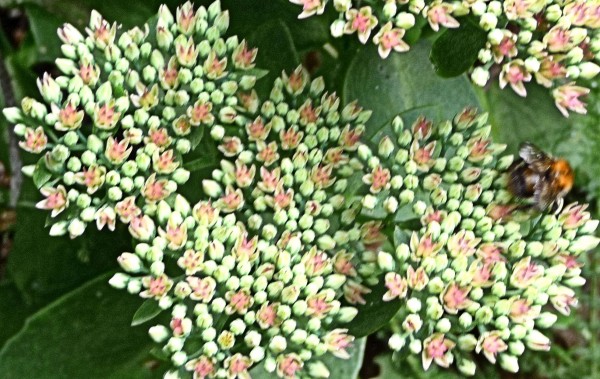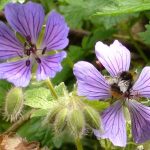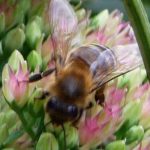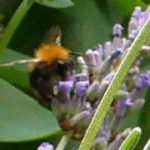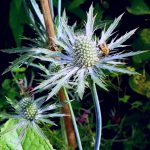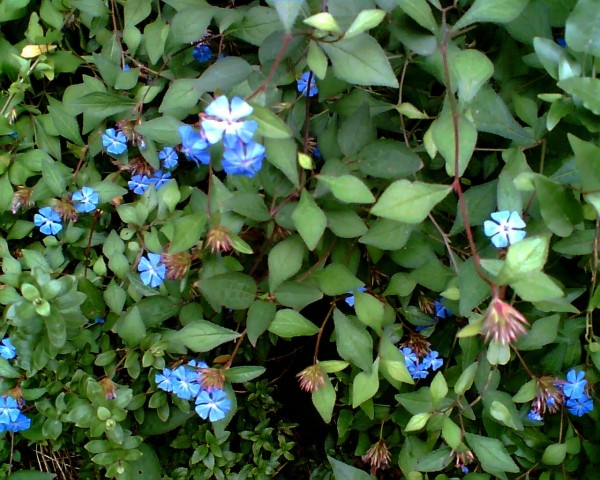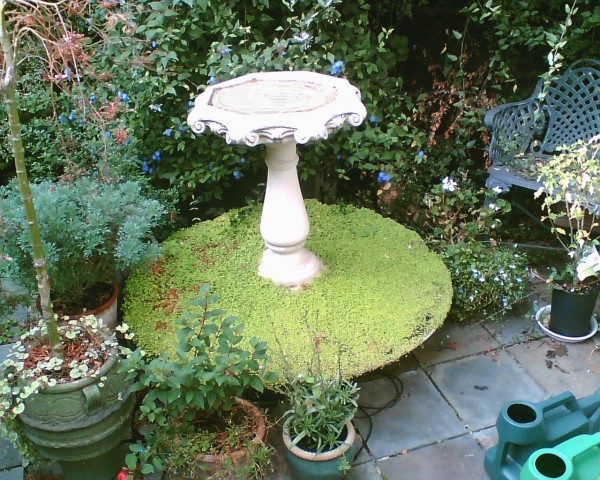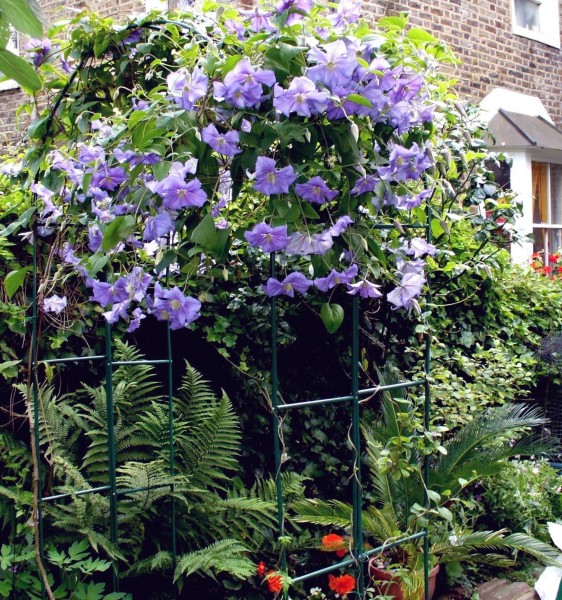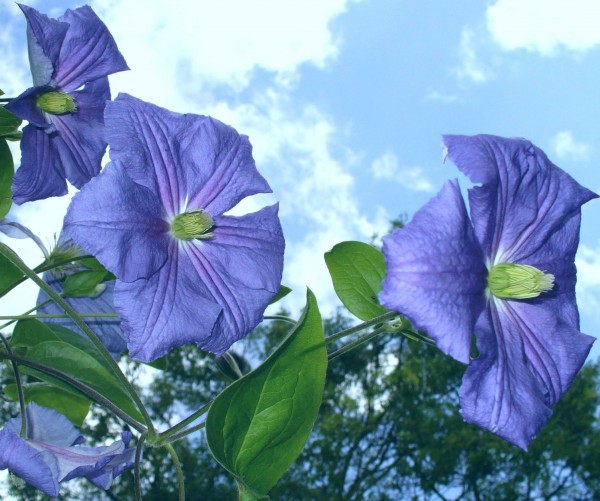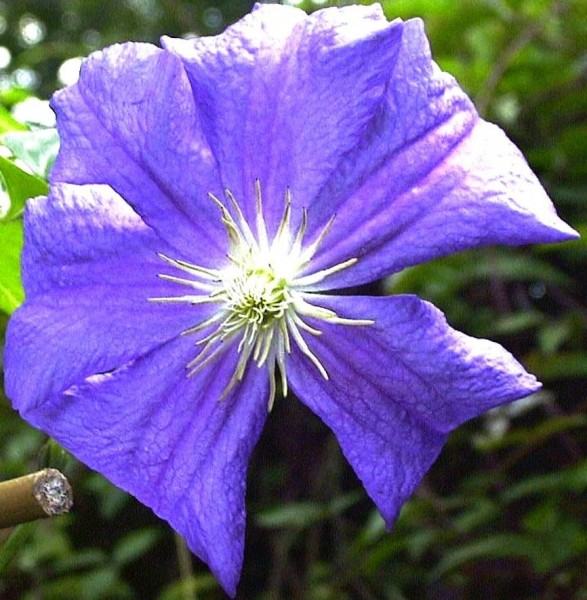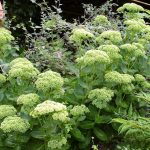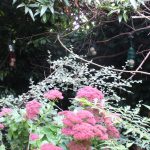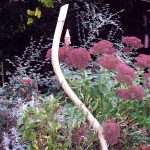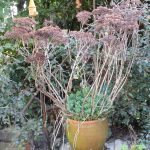Bee’s Favourites: International
Many native wildflowers only bloom for a few months. A wildlife-friendly garden should try to provide pollen and nectar throughout the season for bees, butterflies, hoverflies or other insects, and choosing plants from elsewhere on the planet, with flowering times earlier or later than our natives, makes your garden worth a pollinator’s visit for most of the year.
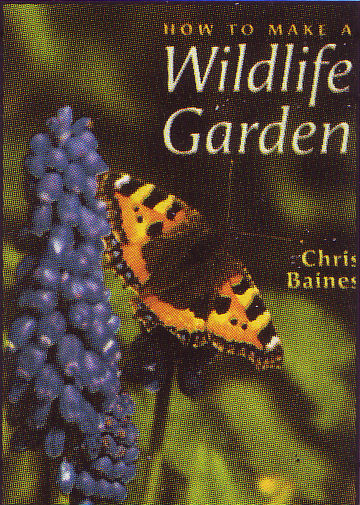 HOW TO MAKE A WILDLIFE GARDEN, by Chris Baines, Frances Lincoln Ltd (revised edition), copyright 1985. First published by Elm Tree Books/Hamish Hamilton, 2000.
HOW TO MAKE A WILDLIFE GARDEN, by Chris Baines, Frances Lincoln Ltd (revised edition), copyright 1985. First published by Elm Tree Books/Hamish Hamilton, 2000.
This is the book recommended to me by the Wildlife Rangers at the Ecology Centre. It is based on Chris Baines’ wildflower garden for the 1985 Chelsea Flower Show (the first wildflower garden ever at Chelsea) and a TV programme, ‘Bluetits and Bumblebees’, from the same year. It is filled with ideas; its author’s warmth and enthusiasm come through on every page.
There are chapters on wildflower meadows, garden ponds, climber-covered screens and ‘cottage garden service stations’. Flowers, native and ‘garden border’, are grouped by colour, height, and flowering times, with tales of how wildlife uses each one. You can delve into this book in the dead of winter and find inspiration for the season to come. Look up Chris Baines on the web and read about his ongoing environmental work, up to and including water sustainability at the Athletes’ Village, London 2012. It is easier now to find expertise on wildlife, thanks to television, radio and the internet, than it was in 1985. But this book is as relevant today as it was then. You will not regret bringing it into your life and letting its ideas influence your garden.
The INTERNATIONALS
These plants, originating elsewhere on the planet, have done well (with a few exceptions) for North London bees and other winged creatures over the last ten years:
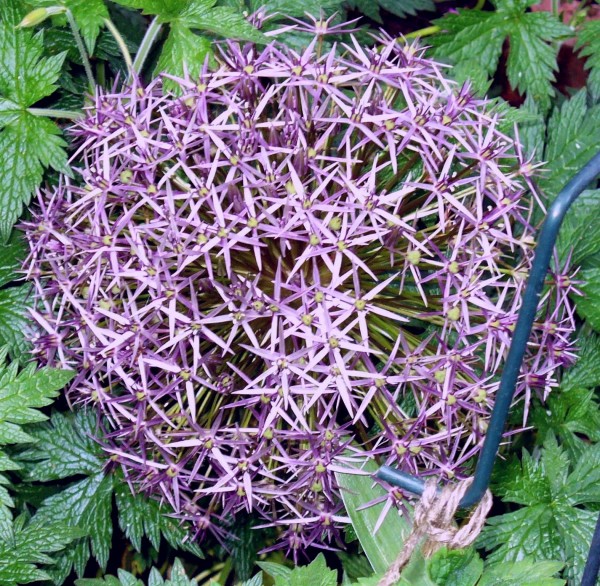 ALLIUM ‘Cristophii’ (Ornamental onion) – Turkey, C. Asia
ALLIUM ‘Cristophii’ (Ornamental onion) – Turkey, C. Asia
Globes of metallic MAGENTA flowers with YELLOW centres arise each season from bulbs. As its foliage (strap-shaped leaves up to 16 inches long) withers before the flower globe appears, Christophii is best surrounded with smaller flowers or foliage. 12-24in x 6-7in.
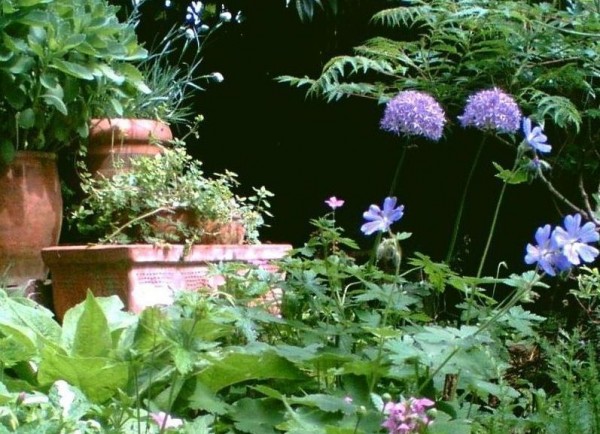 ALLIUM ‘Globemaster’ (Ornamental onion) – C. Asia
ALLIUM ‘Globemaster’ (Ornamental onion) – C. Asia
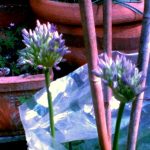
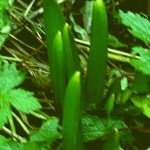 In early spring, strong mid-green leaves push through the soil; at the tip of the stem a sphere appears, covered with small LAVENDER flowers. This flower globe expands gradually, reaching nearly 8 inches across. As with other Alliums, bees are all over the flowers.
In early spring, strong mid-green leaves push through the soil; at the tip of the stem a sphere appears, covered with small LAVENDER flowers. This flower globe expands gradually, reaching nearly 8 inches across. As with other Alliums, bees are all over the flowers.
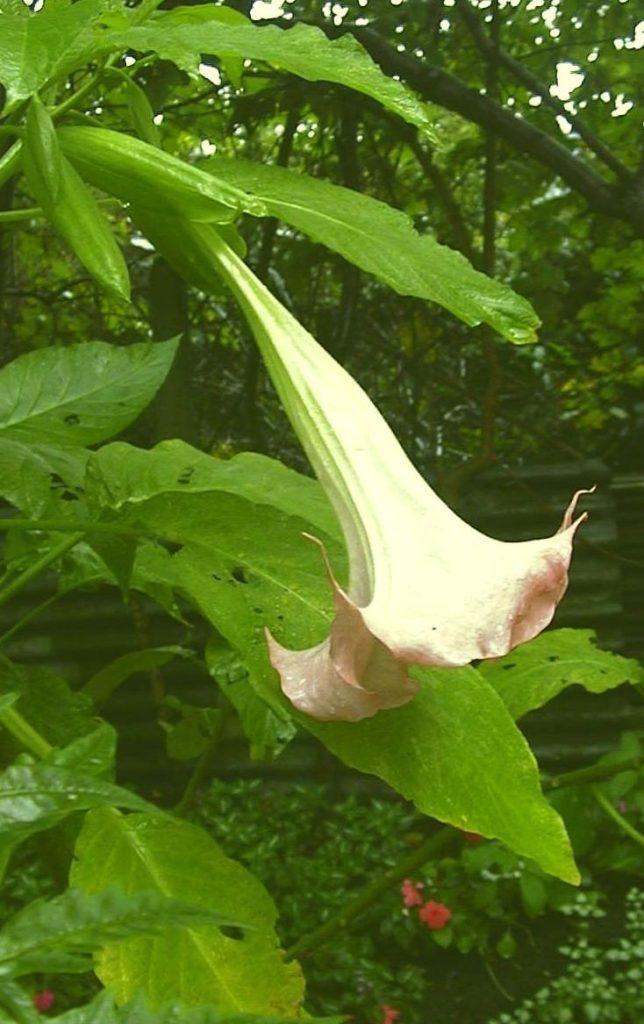 ANGEL’S TRUMPETS (Brugmansia suaveolens) – Southeast Brazil
ANGEL’S TRUMPETS (Brugmansia suaveolens) – Southeast Brazil
This was a ‘patio plant’ from the old Woolworth’s at the Angel, labelled ‘Datura’, with a photograph of the trumpet flower.
I bought it as a bare-rooted stick in the dead of winter, for the balcony of my previous flat, in hopes that the same bees visiting the Nasturtiums would enjoy the trumpet flowers. It grew to quite a size, with buds like small cigars and each leaf the size of my forearm. The elegant, PINK-tinged flowers were spectacular, but they brought no bees, and I saw no moths.
For five years it lived on the balcony, with sparrows perching on its thick stems in the growing season. It was cut down before each winter, and covered with bubble wrap when frost was forecast. It came here with me in spring, in its very large container, summering in the garden. As winter approached, it was covered with bubble wrap – but it didn’t survive. It didn’t want a patio; it wanted a conservatory. Or a warmer climate.
In her gardening column for the Observer, Vita Sackville-West wrote of the Datura’s influence where it grows around the Equator: ‘Nor had I ever been sufficiently grateful for not living in an island where the local burglar blows the pollen of datura in through your open window by means of a blowpipe and helps himself to your possessions while you lie temporarily insensible’.
THE ILLUSTRATED GARDEN BOOK, Vita Sackville-West, A New Anthology by Robin Lane Fox, Michael Joseph, London, 1986.
www.gardeningknowhow.com/ornamental/trees/brugmansia is a website which tells how to overwinter these exotic shrubs.
BERGAMOT (Monarda didyma) – N.America
Also known as Bee Balm. Tea made from it is an aromatic aid to digestion, helping to lower fever. Ours, with deep RED-PURPLE flowers, was a late addition to the garden last year, brought back from the Hornsey Pet and Garden Shop in Crouch End… 2013: Bee Balm was another casualty of winter.
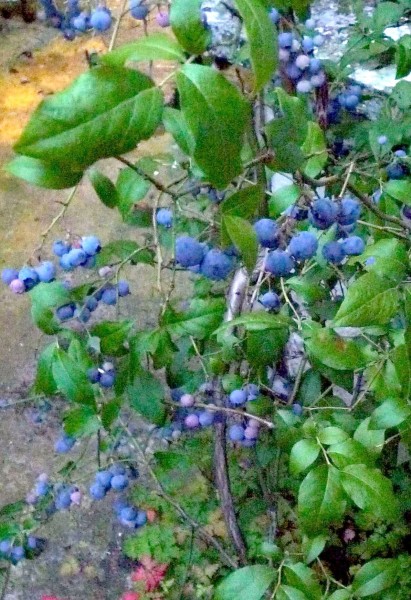 BLUEBERRY (Vaccinium corymbosum) – North America
BLUEBERRY (Vaccinium corymbosum) – North America
Tom’s Highbush Blueberry, planted in ericaceous (acid) soil, lives in a large ceramic pot. It dislikes lime, prefers rain to tapwater. In dry spells it receives filtered water.
PINK buds appear in early February; in late spring and early summer, WHITE flowers appear, with bees pollinating them. A harvest of blueberries follows.
July 2013… The bitter winter and wet spring meant that bee numbers in the garden were down. One of the earliest plants to emerge from the sleep of winter is the Blueberry, but there were no early bees on hand to pollinate its flowers, and blueberry numbers for this season were slow to recover.
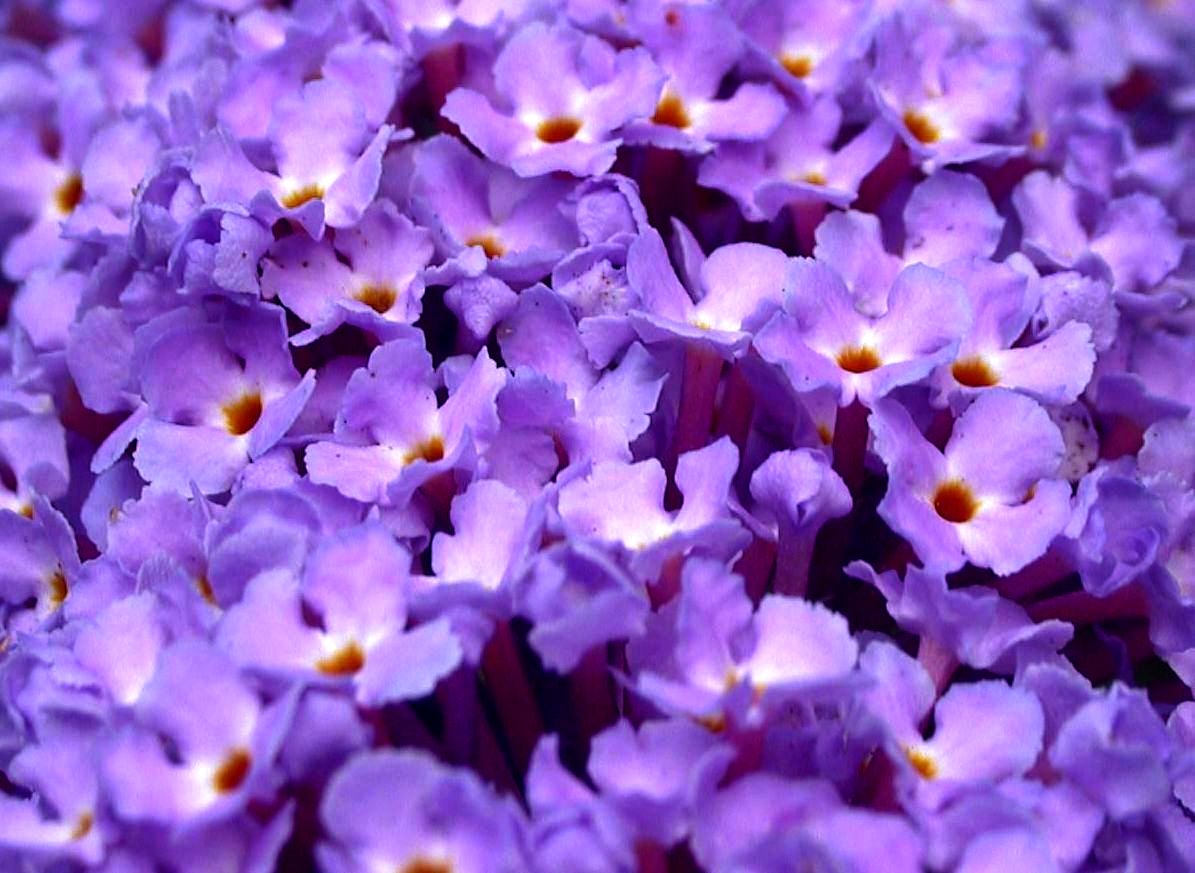 BUDDLEIA (The Butterfly Bush) – China
BUDDLEIA (The Butterfly Bush) – China
A perennial shrub that self-seeds freely, Buddleia can be found all round Highbury. It grows between paving stones, out of brick walls, on bare earth. Before redevelopment, a small Buddleia grew high up on the art deco facade of Highbury Stadium’s East Stand. 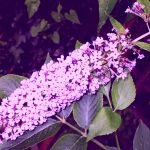
There are a number of cultivars, but Buddleia Davidii ‘Empire Blue’ is most seen locally: panicles of intensely fragrant LAVENDER flowers with RED-ORANGE centres. Some blue-green leaves remain through London winters.
In READING THE LANDSCAPE OF EUROPE, May Theilgaard Watts, visiting London in the years following World War 11, found it growing in bomb craters, along with Elder, Coltsfoot, Canadian Fleabane, Rosebay Willowherb, Oxford Ragwort and Plantain.
Grown in soil and given enough space, the Butterfly Bush makes a shrubby mound 4 metres high. A number of these Buddleia mounds grew in our little woodland before the developer flattened it. We have a young Buddleia in the garden now, grown from a seedling which sprouted in a windowbox. Planted out three years ago, it is being trained to flower at head height. Bring on the butterflies! ………………………………………………………………………………………………………………………………………………………………………..
CENTAUREA MONTANA (Mountain Cornflower) – Europe
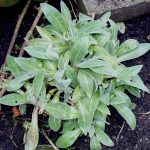
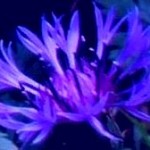
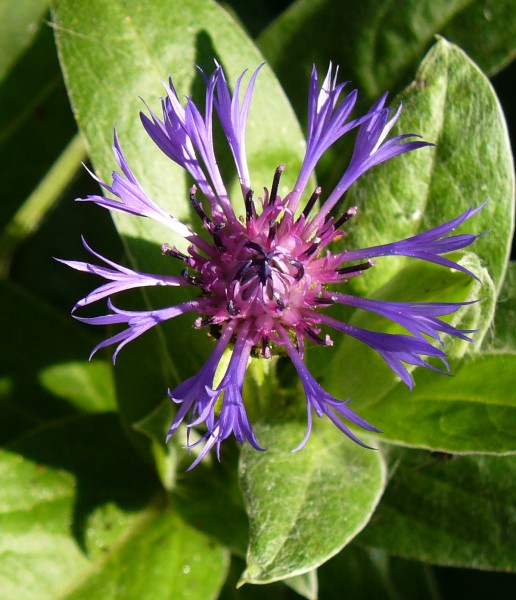 A perennial with soft, furry leaves that appear early in spring, Centaurea Montana grows tall enough to require staking. Its DEEP BLUE flowers are much visited by bees… Will tolerate drought, but not waterlogged soil.
A perennial with soft, furry leaves that appear early in spring, Centaurea Montana grows tall enough to require staking. Its DEEP BLUE flowers are much visited by bees… Will tolerate drought, but not waterlogged soil.
CERATOSTIGMA WILLMOTTIANUM – W. China
 This is a shrub which produces a multitude of small, intensely BLUE flowers., much visited by bees. They bloom from late summer to first frosts, when the plant’s lance-shaped, purple-margined leaves turn red.
This is a shrub which produces a multitude of small, intensely BLUE flowers., much visited by bees. They bloom from late summer to first frosts, when the plant’s lance-shaped, purple-margined leaves turn red.
Ceratostigma Willmottianum is planted in the rock garden behind the Ecology Centre in Gillespie park. My friend Anne has it in her west-facing raised bed in Wimbledon, where it flourishes behind the birdbath and her ‘lawn’ of ‘Mind Your Own Business’.
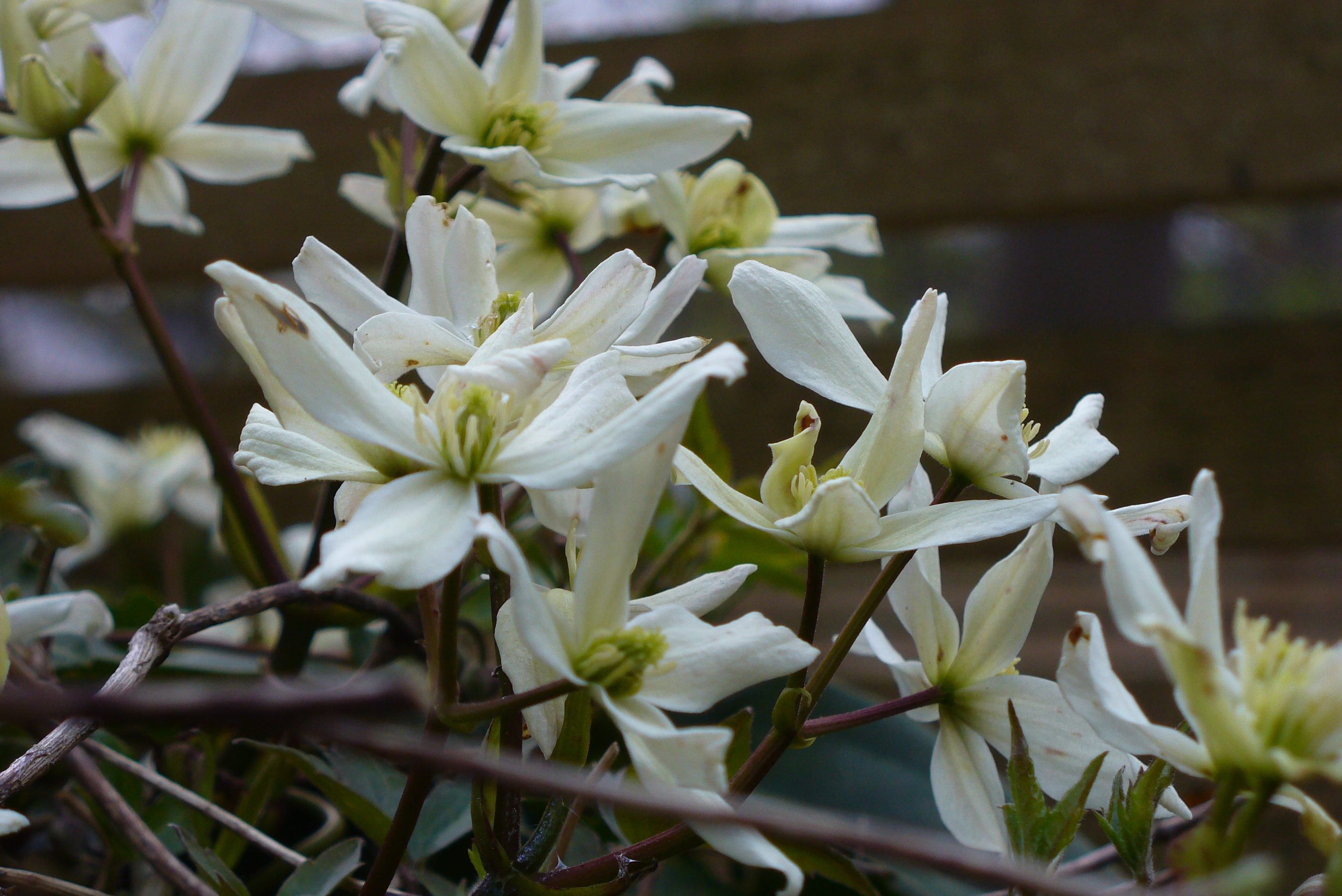 CLEMATIS ARMANDII – China
CLEMATIS ARMANDII – China
This Clematis has, in RF’s words, ‘gone bonkers’. It blankets the small Damson tree on the bank and the back fence with its long evergreen leaves. Buds begin to appear in December; in early spring, fabulously fragrant WHITE flowers cover the leaves. It is left unpruned, except by squirrels.
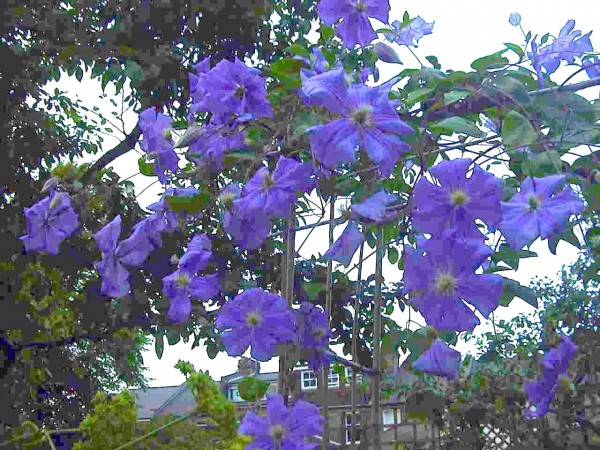 CLEMATIS (Perle d’Azur’)
CLEMATIS (Perle d’Azur’)
This perennial climber shared pergola and rose arch with Morning Glories (MG’s) for years. Its sumptuous, bee-friendly BLUE flowers bloom from June to late Autumn. Its leaves may suffer from powdery mildew by September, but the flowers remain perfect. I spray with dilute washing-up liquid, but nothing more lethal than that. After flowering, cut back to young sideshoots or strong buds lower down.
Penelope Hobhouse wrote of growing it in the garden at Tintinhull, Gloucester, where she underplanted it with Hardy Geranium ‘Wargrave Pink’.
ON GARDENING, Penelope Hobhouse, Frances Lincoln Ltd, Macmillan, 1994.
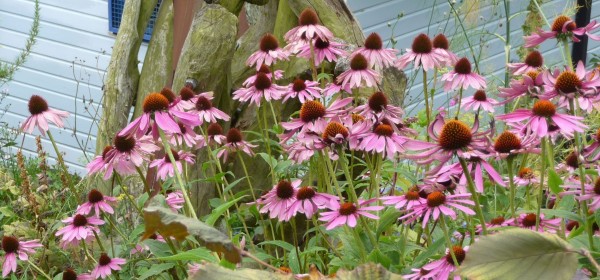 CONEFLOWER (Echinacea) – North America
CONEFLOWER (Echinacea) – North America
A bee favourite from North America, Echinacea likes sunshine and good drainage. It grows in clumps that are five feet high and five feet wide. Cut back stems as flowers fade, to persuade the plant to make more flowers.
Echinacea purpurea, with MAGENTA-PINK petals and GOLDEN BROWN cones at the centres, is ‘now considered the most effective detoxicant in Western medicine for the circulatory, lymphatic, and respiratory systems, and has been adoted by Ayurvedic practitioners.’ ‘The generic name Echinacea comes from the Greek echinos “hedgehog” and refers to the prickly scales of the flower’s central cone.’
RHS ENCYCLOPEDIA OF HERBS, Demi Bown
Photo – Gillespie Park
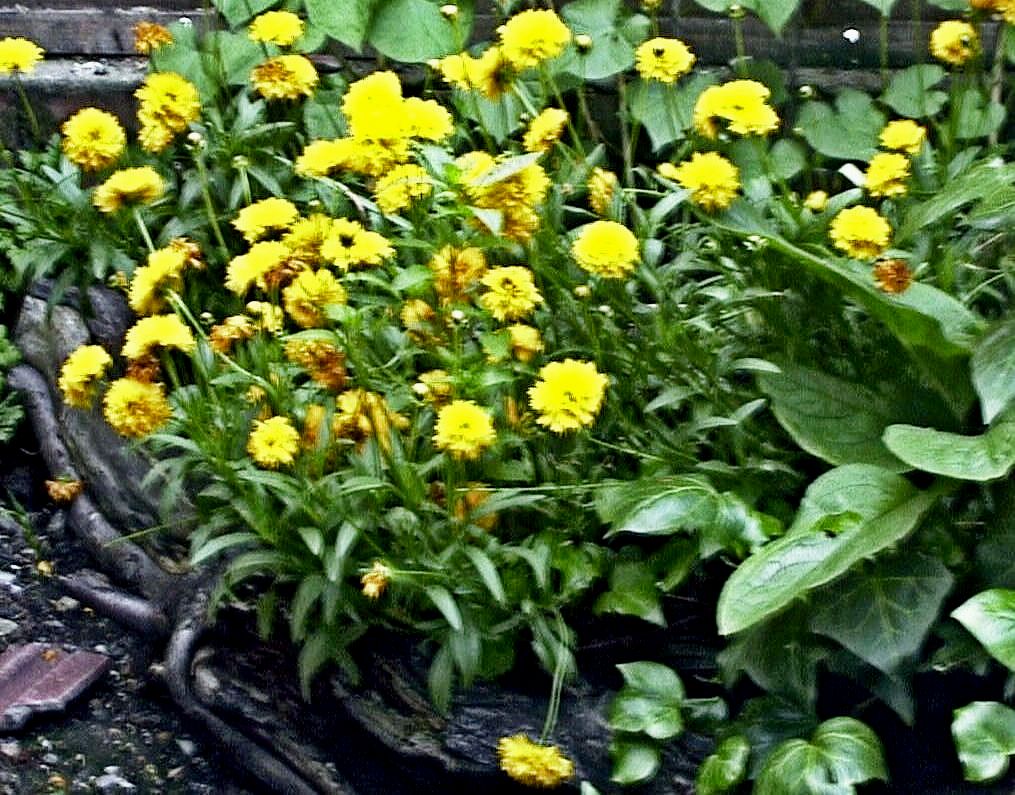 COREOPSIS (Tickseed) – Mexico, North and Central America
COREOPSIS (Tickseed) – Mexico, North and Central America
The shiny buds of this perennial open into vivid YELLOW flowers; they bloom from summer into late autumn, and are much visited by bees. Pinching off the spent flowerheads persuades the plant to make more flowers. A taller version in my mother’s garden drew finches and sparrows in Autumn to feast on its seeds.
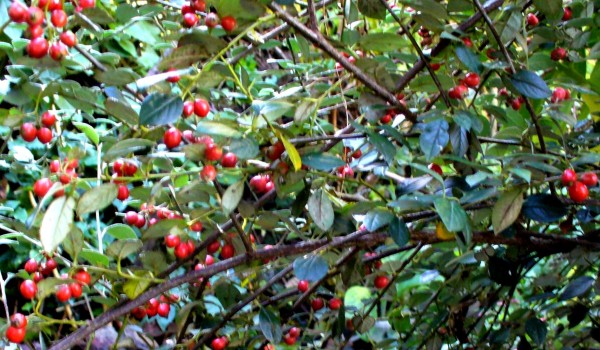 COTONEASTER – N. Temperate regions of Europe, Asia and N.Africa
COTONEASTER – N. Temperate regions of Europe, Asia and N.Africa
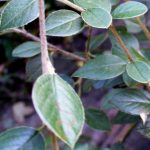 This Cotoneaster, which I call ‘Anne’s Bee Bush’, came from her garden in Wimbledon. Previous owners had planted its parent outside her French doors, where it had grown into a formidable security guard, doing its best to stop anyone getting into the garden. We cut it back hard all round, dug out its rootball and moved it further away from the house, into a high raised bed Anne had built.
This Cotoneaster, which I call ‘Anne’s Bee Bush’, came from her garden in Wimbledon. Previous owners had planted its parent outside her French doors, where it had grown into a formidable security guard, doing its best to stop anyone getting into the garden. We cut it back hard all round, dug out its rootball and moved it further away from the house, into a high raised bed Anne had built.
The parent plant grows to a height of three metres, left to its own devices. Its Highbury child is kept smaller, dividing the earthwork from the birds’ suet feeder array. Its PINK flowers bring in the bumblebees; RED berries follow, welcomed by birds in winter.
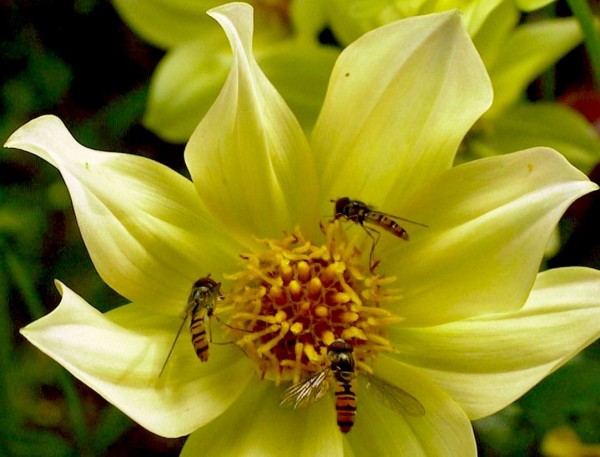 DAHLIA – Mexico and C.America
DAHLIA – Mexico and C.America
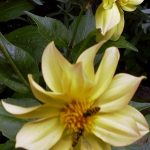
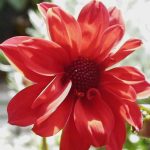 RF had a number of Dahlias; some of them were of no interest to pollinators. Hoverflies and other insects preferred this YELLOW one. Removal of spent flowers brings on further blooms.
RF had a number of Dahlias; some of them were of no interest to pollinators. Hoverflies and other insects preferred this YELLOW one. Removal of spent flowers brings on further blooms.
 DELPHINIUM (Pacific Hybrid)
DELPHINIUM (Pacific Hybrid)
A vivid BLUE beauty from Chessington Garden Centre, ignored by insects. Not worth landing on, not even to rest one’s wings.
Unlike the native Larkspur (Delphinium ajacis), which has WHITE, PURPLE and BLUE flowers and is pollinated by bees, no local bees fancied this Hybrid. Perhaps some sort of insect repellent was bred into it. Useless to a wildlife garden. After its flowers had finished, it was put into the compost. Never again. Next time find a Larkspur.
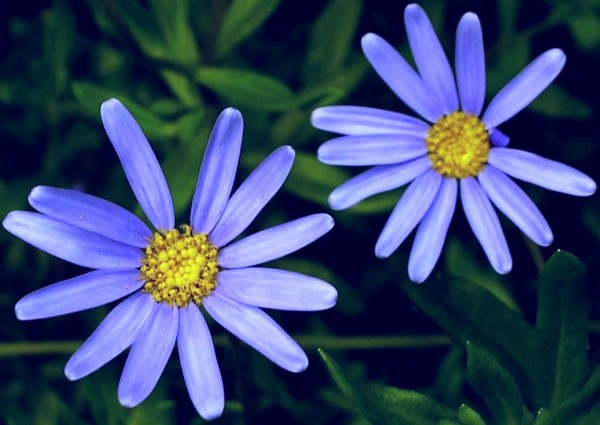 FELICIA AMELLOIDES (Blue Daisy) – South Africa
FELICIA AMELLOIDES (Blue Daisy) – South Africa
Small, shiny leaves and bright BLUE daisy flowers. Keep it watered and pinch off spent flowers to encourage new ones. Bees love it. Tender, may not survive outdoors in winter.
2013: This year’s plant, after withstanding everything winter had to offer, flowers freely but has no visiting bees.
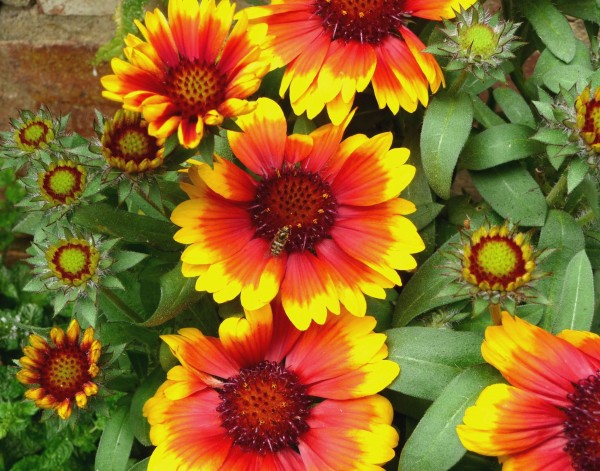 GAILLARDIA ‘Goblin’ (Blanketflower) – Temperate regions of North and South America.
GAILLARDIA ‘Goblin’ (Blanketflower) – Temperate regions of North and South America.
 A colourful firework of a flower, Gaillardia has RED petals tipped with YELLOW round a central mound of MAHOGANY, on which bumblebees browse enthusiastically. They often look to be hugging the mound.
A colourful firework of a flower, Gaillardia has RED petals tipped with YELLOW round a central mound of MAHOGANY, on which bumblebees browse enthusiastically. They often look to be hugging the mound.
Tolerates poor soil. Cut back in late summer to 6 inches, allowing new growth at the base to overwinter. Ours, never surviving the winter, have always had to be replaced. Some Gaillardia are more magnetic to bees than others.
GERANIUM Pratense ‘Mrs Kendall-Clarke’ (Cranesbill) – Europe, C.Asia
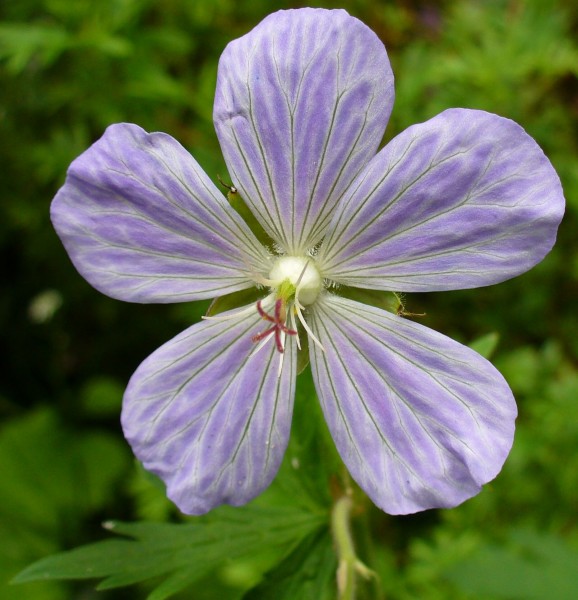 LAVENDER-BLUE flowers with silver markings, held vertically; large, deeply cut leaves. Flowering season not as long as Wargrave Pink or Buxton’s, but fabulous while in bloom and much loved by bees.
LAVENDER-BLUE flowers with silver markings, held vertically; large, deeply cut leaves. Flowering season not as long as Wargrave Pink or Buxton’s, but fabulous while in bloom and much loved by bees.
Ours, planted by someone for a class at the Ecology Centre, was left behind; it ended up beside the back porch, with other plants in pots. After a clear-out, the now-potbound Mrs Kendall-Clarke was brought here and planted out in what was meant to be her own bed.
But a robust neighbour, Hardy Geranium ‘Wargrave Pink’, moved in, self-seeding itself and bullying the new arrival until it had taken over most of her soil and sunlight. All of this only came to light when it was time to move the plants.
Now Mrs Kendall-Clarke lives on the earthwork. Only one other Hardy G., one with a BLUE flower, grows near her. As their leaves are so different, any Wargrave Pink seedlings appearing on the bank are easily spotted and moved elsewhere.
GERANIUM Wallichianum ‘Buxton’s Variety’ (Cranesbill) – Himalayas, N. India, Kashmir
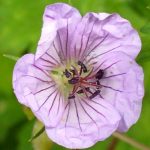 Prolific OPAL BLUE flowers that carry on blooming until first frosts. Leaves are matt green with cream spots. Bees love it. RF ordered this one and it came by post. Unlike its fellow Hardy G.’s, Buxton’s does not seed itself round the garden, growing instead from a tap-root.
Prolific OPAL BLUE flowers that carry on blooming until first frosts. Leaves are matt green with cream spots. Bees love it. RF ordered this one and it came by post. Unlike its fellow Hardy G.’s, Buxton’s does not seed itself round the garden, growing instead from a tap-root.
After years of letting its extravagant growth roll over its neighbours, it is now restricted to a large container. Last year it mingled with Mints and Hardy G. ‘Wargrave Pink’.
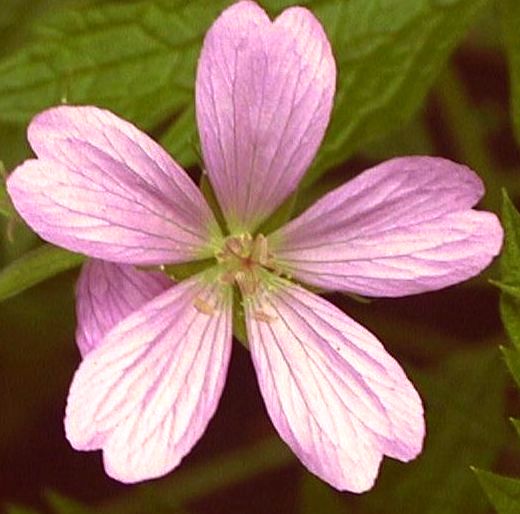 GERANIUM x Oxonianum ‘Wargrave Pink’ (Cranesbill)
GERANIUM x Oxonianum ‘Wargrave Pink’ (Cranesbill)
Described as ‘robust’ and ‘vigorous’, its bright PINK flowers appear in pairs at the end of each stem. Pinching these off when they are spent brings on more flowers, all visited constantly by bees over its long flowering season. 
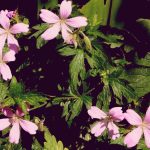 2013: Virtually no bees visited Wargrave Pink this year.
2013: Virtually no bees visited Wargrave Pink this year.
 HELENIUM (Helen’s flower) – North and Central America
HELENIUM (Helen’s flower) – North and Central America
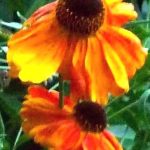 It grew on the earthwork for a season and was popular with the bees. New spring growth struggled, and gave up. Squirrels had, we found, taken to sitting on the new growth. Difficult to grow with a squirrel sitting on you…
It grew on the earthwork for a season and was popular with the bees. New spring growth struggled, and gave up. Squirrels had, we found, taken to sitting on the new growth. Difficult to grow with a squirrel sitting on you…
 HEUCHERA Micrantha ‘Palace Purple’ (Coral Bells) – North America
HEUCHERA Micrantha ‘Palace Purple’ (Coral Bells) – North America
Bees visit the tiny PINK flowers of this perennial, known for its decorative foliage. Ours was a gift from Anne, and each leaf is a work of art. Easy to grow; the rootstock tends to lift itself higher each year, so mulching is advised.
The painting is from a Plants and Planting Design course at Capel Manor…
 IPOMOEA TRICOLOR (Morning Glory ‘Heavenly Blue’) – South and Central America
IPOMOEA TRICOLOR (Morning Glory ‘Heavenly Blue’) – South and Central America
Heart-shaped leaves, Trumpets of SKY BLUE flowers with CREAM throats and long buds that look like furled satin umbrellas. Flowers open in the morning, each lasting for only a day. In our climate, Ipomoeas will flower outside till the first frosts.
RF grew Morning Glories from seed, raising them in his airing cupboard. He kept a yearly gardening journal, making notes – the date he bought a plant, what was flowering and when, the weather… His father, who had a greenhouse, also grew Morning Glories. During the growing season, when they spoke on the phone, they compared numbers of how many Morning Glories had opened that day – ‘The MG Count.’ RF could look back at his previous journals to see what the MG Count had been in other years…
When we stopped using the blue snail pellets, slugs and snails savaged any MGs planted out in the ground. Our solution was to plant them in pots and hang them on the rose arch, wrapping copper tape round its uprights, close to the ground. I now use small bits of copper pipe, left after a plumbing job, placed strategically. An electric charge is said to surge through the slug or snail as they come into contact with copper, making them drop off… they can then look elsewhere for something to slime and devour. In this garden, they are welcome to Garlic Mustard leaves…
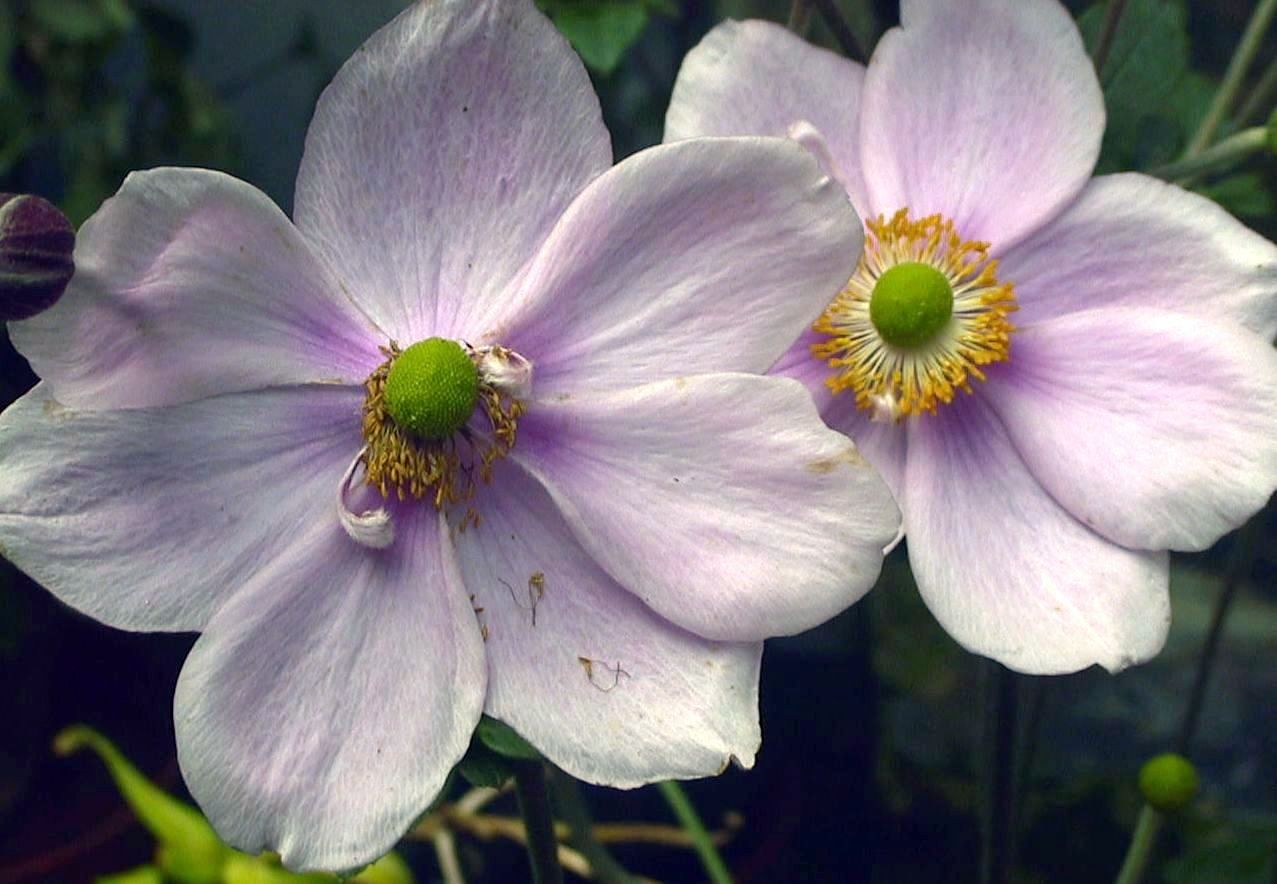 JAPANESE ANEMONE (Anemone x hybrida) (Windflower)
JAPANESE ANEMONE (Anemone x hybrida) (Windflower)
In early Autumn, Windflowers come into their own, their PASTEL PINK or WHITE flowers on long stems blowing in the breeze… Anne’s front garden in Wimbledon was filled with them.I helped her dig them out, and brought two plants back to Highbury. We thought we had pulled up everything, but it seems that the tiniest morsel of root left behind will send up new stems, new flowers. Anne’s front garden still has Japanese Anemones; it is as though they had never left. A brick pit or large pot may restrict the roots of Windflower for some time… but, in an open garden, expect it to spread.
LAMIUM MACULATUM (Deadnettle) – Europe & N.Africa to W.Asia
 The silver-striped, evergreen leaves of this plant persist through winter; in spring it is the first to flower in our London garden, and often the last in bloom as winter moves in. Its flowers are a rich, plummy VIOLET, with bees nestling under the hoods month after month.
The silver-striped, evergreen leaves of this plant persist through winter; in spring it is the first to flower in our London garden, and often the last in bloom as winter moves in. Its flowers are a rich, plummy VIOLET, with bees nestling under the hoods month after month. 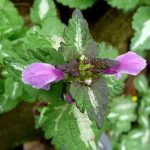
Untroubled by pests or diseases, Lamium maculatum grows by seeds, roots, and stolons, covering the ground over which it rambles. It has no problems growing in clay soil. Best not planted near anything smaller, (Ivy-leaved Toadflax or Mind Your Own Business here), as it may overwhelm them.
A sizable Lamium went back with Brenda and Drew to their new garden, with some Highbury worms. Lamium and worms reported doing well.
 LAVENDER (Lavandula angustifolia) – W. Mediterranean
LAVENDER (Lavandula angustifolia) – W. Mediterranean
Fabulous fragrance, loved by bees. As it comes from the Mediterranean, Lavender requires plenty of sand and gritty drainage… Two large pots of Lavender, from the balcony of my previous flat, were planted out in the garden here in 2001 – ‘English’ Lavender, BLUE flowers on blue-grey stems and leaves, and Lavandula Stoechas, MAGENTA flowers with ‘rabbit-ears’. The ‘English’ lavender lasted for years, but the Stoechas succumbed to downy mildew. Its successors suffered the same fate. 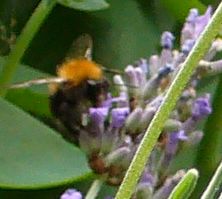
MINTS
Visited by Mint Moths, these three mints came from the garden centre by Peckham Station. Mints are best planted in containers, that they may not overwhelm nearby plants. These die off above ground each winter in their pots, but come back in spring. One mint I WANTED to cover the ground was the native wildflower, CALAMINT. It had leaves of acid green, with small, PALE BLUE flowers appearing intermittently along its stems… It didn’t survive the winter.
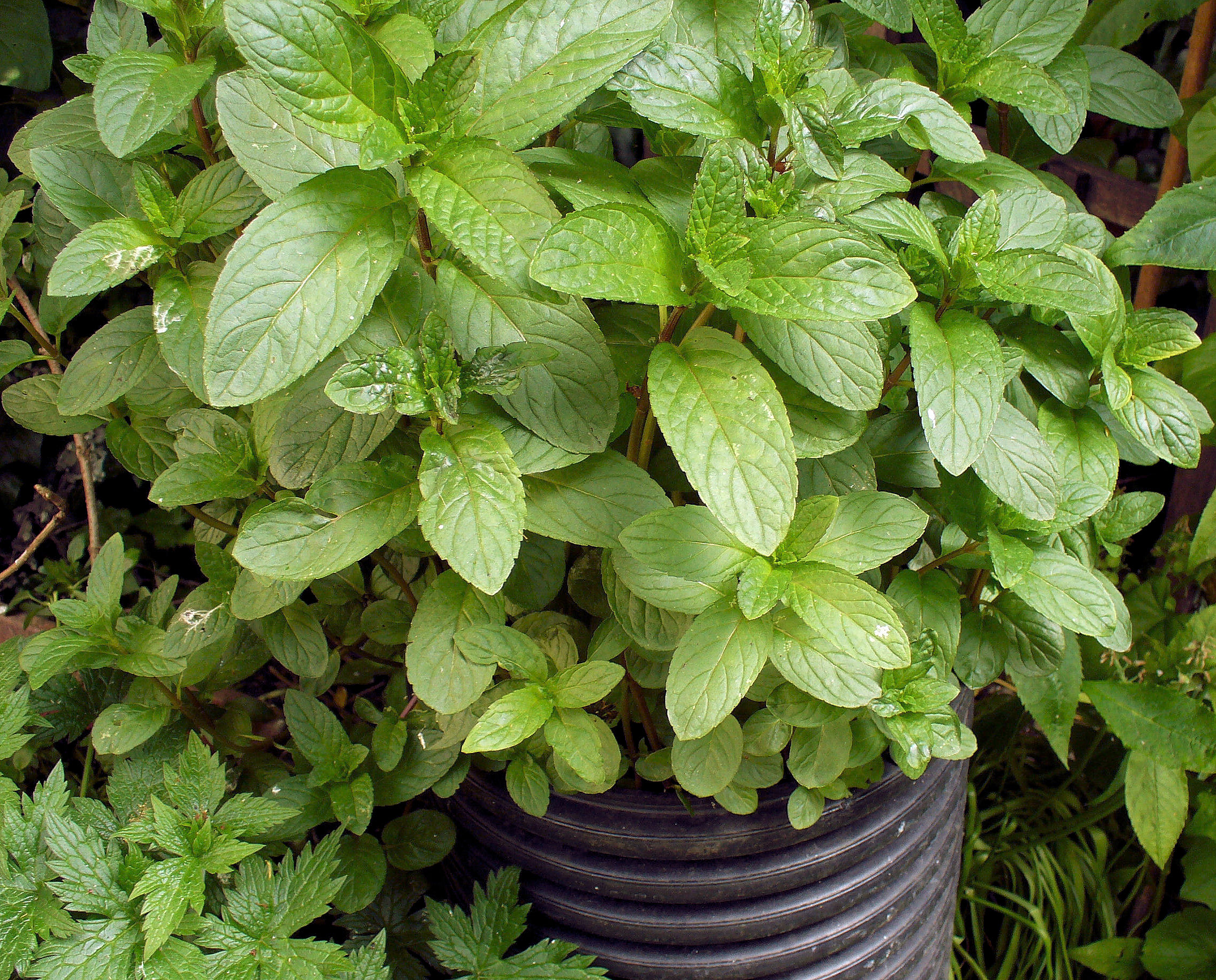 BLACK PEPPERMINT (Mentha x piperita)
BLACK PEPPERMINT (Mentha x piperita)
Small spires of tiny, WHITE/PINK flowers, leaves a dramatic black and (green?) Ruffle your hand through its leaves whenever you pass it… fantastic fragrance wafts up and surrounds you…
 MOROCCAN SPEARMINT (Mentha spicata) – Mediterranean , W. and C. Europe
MOROCCAN SPEARMINT (Mentha spicata) – Mediterranean , W. and C. Europe
Used to brew Moroccan tea… Leaves are a fresh green, with tiny WHITE flowers on small spires in June.
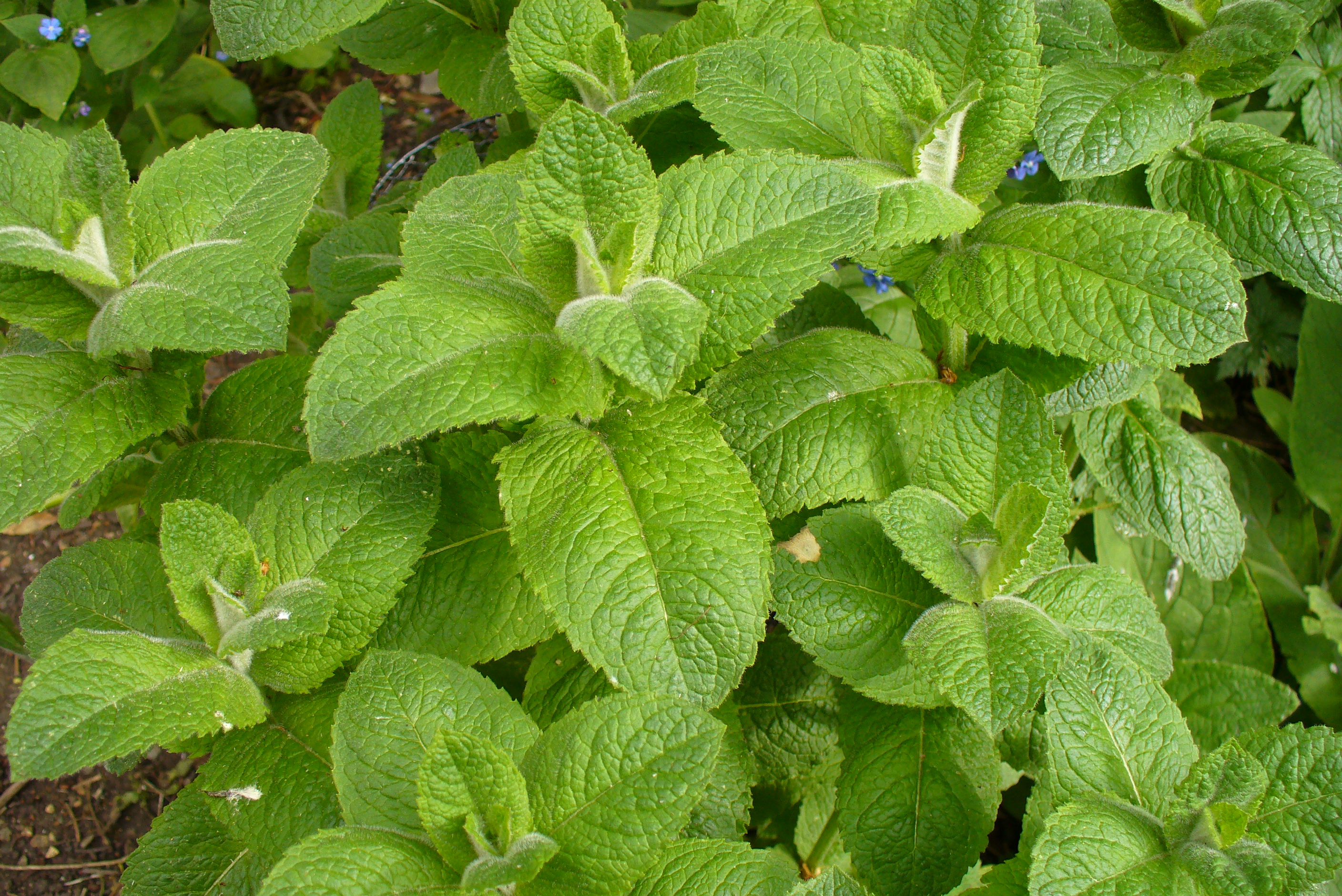 APPLEMINT (Mentha suaveolens) – Europe, Africa & Asia, Mediterranean
APPLEMINT (Mentha suaveolens) – Europe, Africa & Asia, Mediterranean
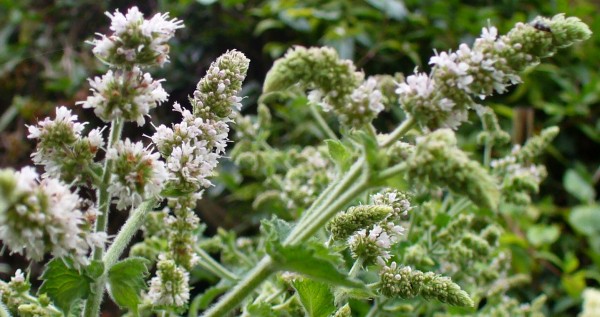 Large, soft, rounded leaves on stems that reach one metre (36 inches). In June, tiny WHITE flowers appear at the stem tips. They are visited, as shown in this video, by Bumblebees and Mint Moths, among others. The leaves of our Applemint are usually coated in powdery mildew by the end of summer. Last year the plant blew over in high winds before I could stake it, leaning into foliage and flowers of Hardy Geraniums ‘Wargrave Pink’ and ‘Buxton’s Variety’. I left it where it was, and the powdery mildew never got to it. The Hardy G’s, free of pests and diseases, seem to have helped a neighbour resist its seasonal coating of powdery mildew. Companion planting! VID 2 -Bumblebee & Mint Moth
Large, soft, rounded leaves on stems that reach one metre (36 inches). In June, tiny WHITE flowers appear at the stem tips. They are visited, as shown in this video, by Bumblebees and Mint Moths, among others. The leaves of our Applemint are usually coated in powdery mildew by the end of summer. Last year the plant blew over in high winds before I could stake it, leaning into foliage and flowers of Hardy Geraniums ‘Wargrave Pink’ and ‘Buxton’s Variety’. I left it where it was, and the powdery mildew never got to it. The Hardy G’s, free of pests and diseases, seem to have helped a neighbour resist its seasonal coating of powdery mildew. Companion planting! VID 2 -Bumblebee & Mint Moth
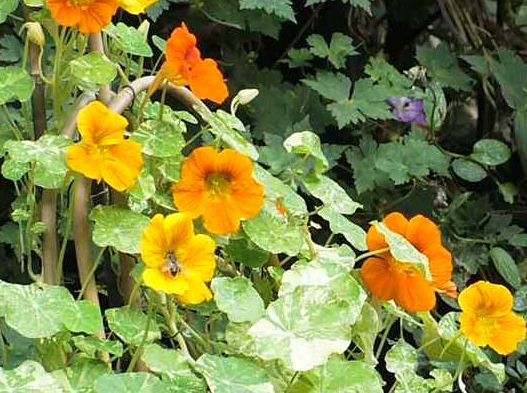 NASTURTIUM (Tropaeolum) – Chile, Peru
NASTURTIUM (Tropaeolum) – Chile, Peru
An annual, with disc-shaped leaves held horizontally, and bright flowers that are loved by bees. ‘Alaska’ has small lime green leaves with creamy mottling, and flowers in shades of YELLOW, ORANGE and RUST. Bees climb inside the flower funnels and emerge covered with pollen… When each flower has been pollinated, it bows down…
Let some go to seed, but pluck off most of the flowers once they have gone over, to persuade the plant to make more. If blackfly are a problem, and ladybirds or birds not keeping the numbers down, the plant may be sprayed with a little washing-up liquid in water. Blackfly and greenfly dislike the slick coating on the leaves.
Nasturtiums are not hardy enough to survive our winters unless kept in greenhouse or conservatory.
 PASSIONFLOWER (Passiflora) – Tropical N., C. & S. America
PASSIONFLOWER (Passiflora) – Tropical N., C. & S. America
These evergreen climbers are tender, but some do survive outdoors in London.
Wildlife Ranger Louisa and Ecology Centre volunteers have managed to grow one on a site near the Regents Canal, on a pergola. Louisa said that two Passionflowers were lost to winter cold before a third managed to survive. The most amenable to our climate is Passiflora Cerulea, with BLUE flowers.
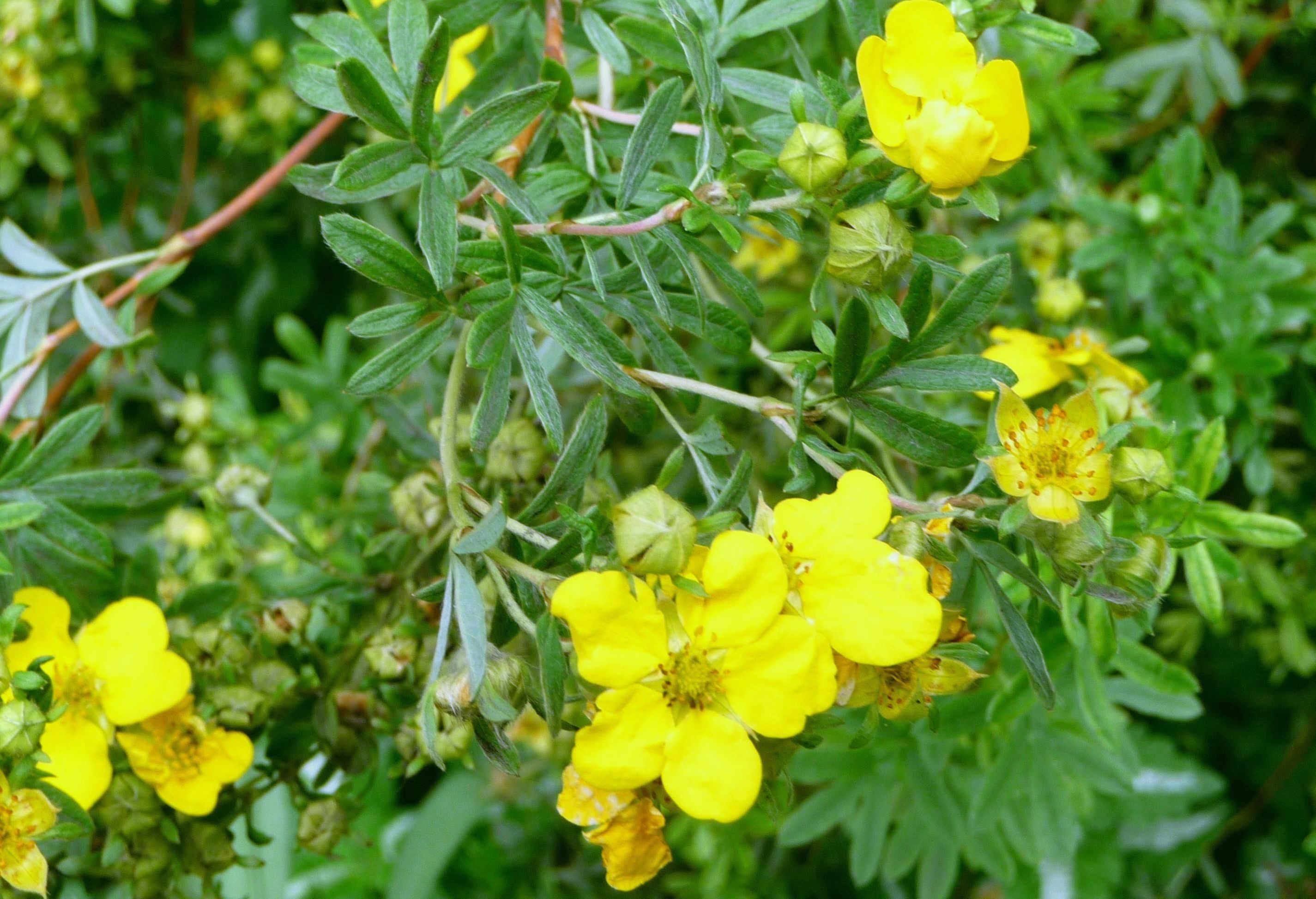 POTENTILLA (Cinquefoil) – Northern hemisphere
POTENTILLA (Cinquefoil) – Northern hemisphere
A pitiful sight in winter, this small shrub is a mass of dry, brown, twiggy sticks. Small, neat sprays of leaves arrive in late spring, with YELLOW flowers which bloom to mid-autumn.
Wants no special treatment, suffers from no pests or diseases. Visited by a succession of bees…
2013: Virtually no bees this year for the Potentilla. The long cold winter and wet spring have taken their toll.
 PYRACANTHA (Firethorn) – S. Europe to S.W. Asia, the Himalayas, China & Taiwan
PYRACANTHA (Firethorn) – S. Europe to S.W. Asia, the Himalayas, China & Taiwan
The WHITE flowers of this evergreen climber are much visited by bees in spring; ORANGE berries follow, and may last into winter for hungry birdlife. A good hedging shrub, but sharp thorns may macerate passing humans unless it is kept clipped or tied back.
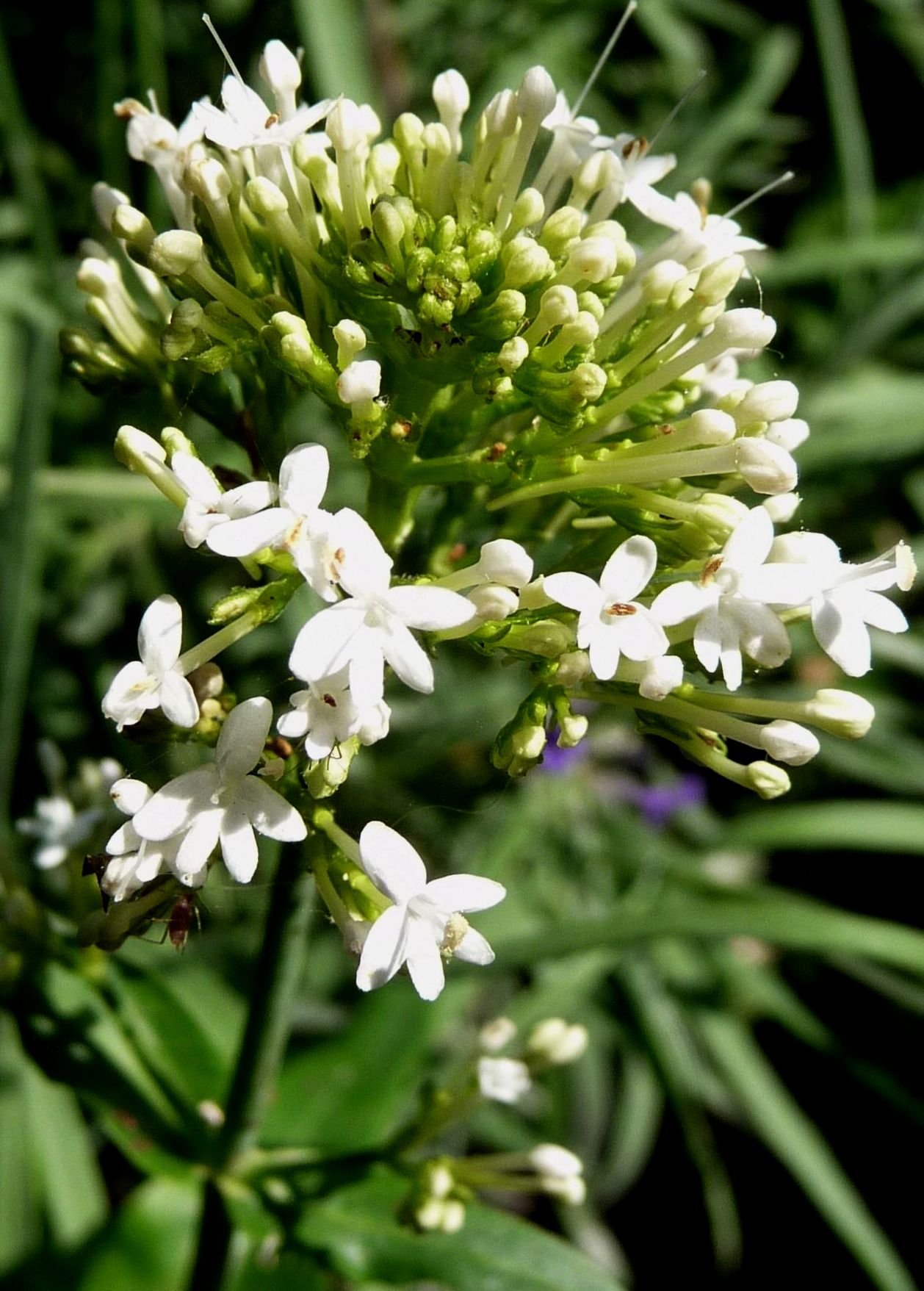 RED VALERIAN (Centranthus ruber) – Mediterranean, S. Europe to Turkey, N. Africa
RED VALERIAN (Centranthus ruber) – Mediterranean, S. Europe to Turkey, N. Africa
Long-flowering Valerian likes to spill over old walls and stony banks. Ours, ‘St George’ (WHITE and RED), was grown from seed. It struggled with invading Bindweed tendrils from next door, and was moved onto the earthwork. Then it gave up. Worth trying again. Bees loved it.
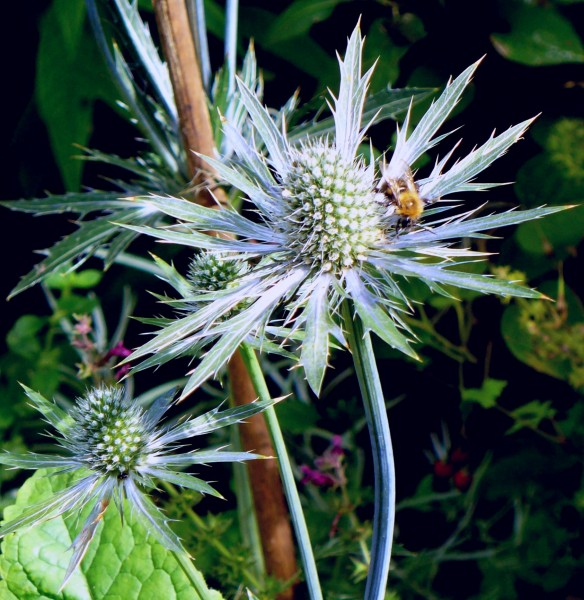 SEA HOLLY (Eryngium) – Turkey, N. Africa, coasts of most European countries
SEA HOLLY (Eryngium) – Turkey, N. Africa, coasts of most European countries
Spiky, metallic BLUE flowers were visited by bees and other insects for one season. It survived the winter and began emerging from the soil in early spring … Then it got eaten, probably by mice or squirrels, as slugs and snails weren’t yet out and about. Other attempts to grow Eryngiums have failed to date, but this one managed to regrow this season… 
The native Sea Holly (Eryngium maritimum) likes sandy soil; BLUE flowers from June to August are followed by egg-shaped fruits. Its roots, which can be 2 metres (6 feet) in length (!) were dug up and roasted, or candied and eaten as sweets (‘Eryngoes’).
Wikipedia quotes Falstaff, praising it as an aphrodisiac.
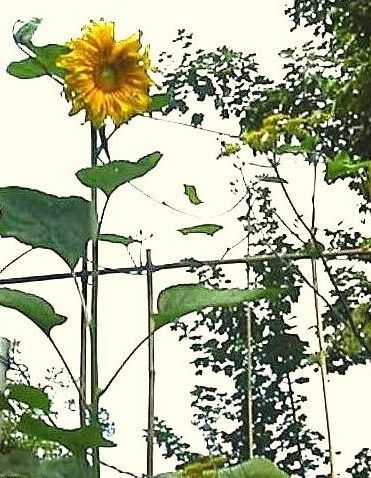 SUNFLOWER (Helianthus) – The Americas
SUNFLOWER (Helianthus) – The Americas
Many birds love sunflower seeds… and there are a number of varieties of sunflower for humans and birds to enjoy. Monika, who lived here before I moved in, was keen to see sunflowers in the garden and said so to RF. He did his best, planting them year after year, and sunflowers did grow from the seeds… But each plant was brought down by squirrels, who captured the flowerheads and devoured all the seeds, leaving none for the birds…
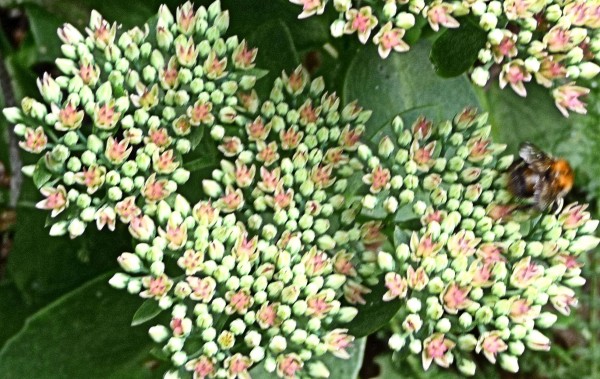 THE ICE PLANT (Sedum Spectabile) – China, Korea
THE ICE PLANT (Sedum Spectabile) – China, Korea
Its succulent, pastel green stems and leaves appear suited to a hot climate, even a desert… But Sedum Spectabile survives icy winters.
Its flowerheads (corymbs) look like heads of PASTEL GREEN broccoli at first… One flower at a time changes to a MUTED PINK;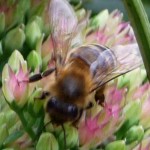 the Ice Plant is now at its most alluring to bees, who are all over it. Gradually the corymbs become a rich MAUVE, pleasing to the human eye but of no further interest to the bees. They then deepen to a dark REDDISH-PURPLE, then a RUSTY BROWN.
the Ice Plant is now at its most alluring to bees, who are all over it. Gradually the corymbs become a rich MAUVE, pleasing to the human eye but of no further interest to the bees. They then deepen to a dark REDDISH-PURPLE, then a RUSTY BROWN.
By December, new pastel green rosettes the size of marbles nestle at the base of the old plant, waiting for spring…
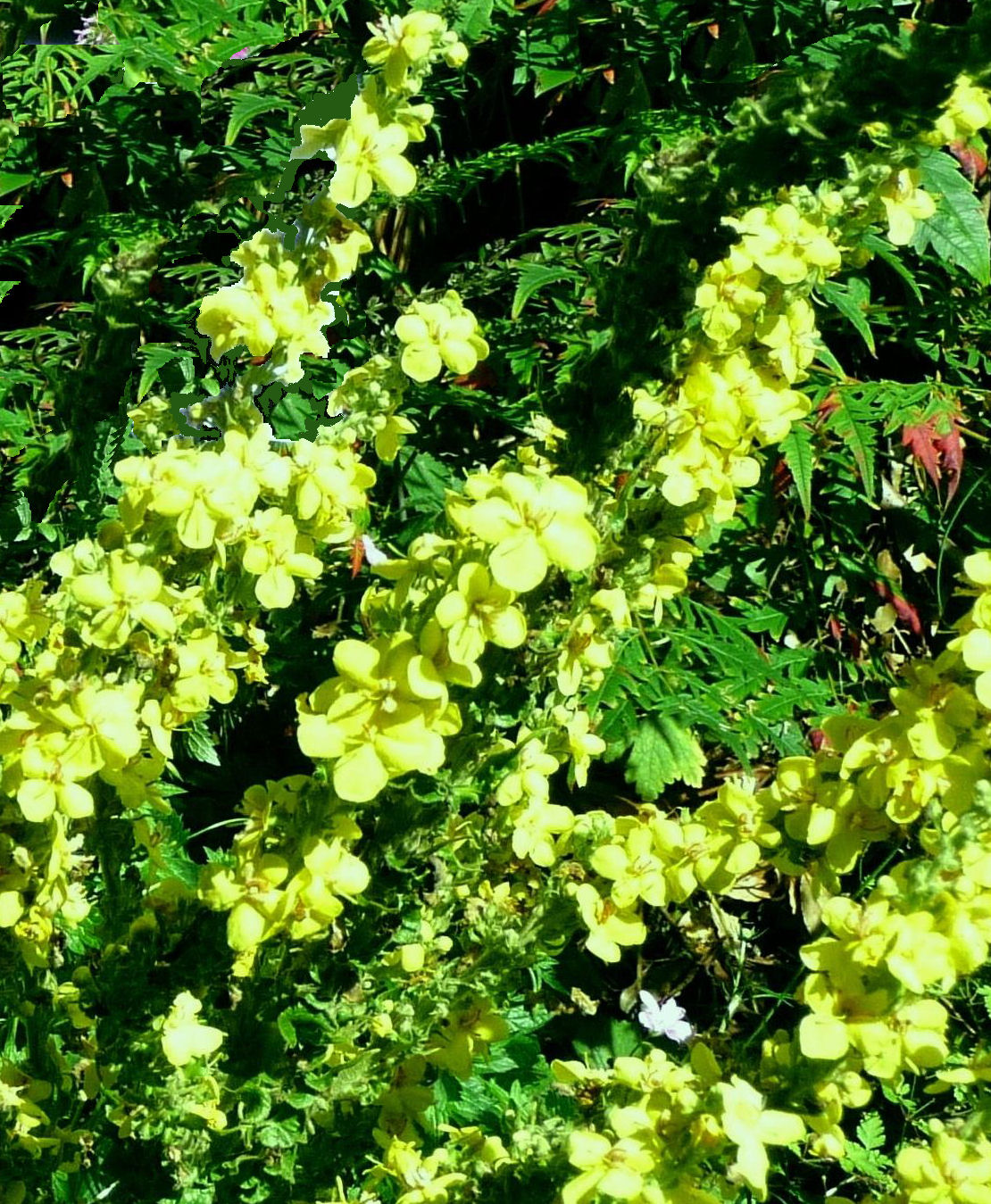 VERBASCUM OLYMPICUM (Mullein) – Greece
VERBASCUM OLYMPICUM (Mullein) – Greece
A candelabra from Mt Olympus, a biennial that prefers poor soil. It puts out a rosette of leaves in its first year, growing to nearly two metres tall in year two. The bright YELLOW flowers are worth waiting for.
Gillespie Park had seven of these Greek candelabras the year we grew this one. They got better all-round sunshine in the rock garden behind the Centre, and were still flowering when ours had gone over. Smaller birds enjoyed clinging to the candelabra’s spent flower spike and pecking their way enthusiastically through the seeds…
There is a native mullein, known as ‘Aaron’s Rod’…
 VERBENA BONARIENSIS – S America, Brazil to Argentina
VERBENA BONARIENSIS – S America, Brazil to Argentina
Tall, square stems, two metres high, with clusters of tiny PINK flowers at the tips… A bee favourite, grown in several local Highbury front gardens.
Christopher Lloyd planted this perennial in his garden at Great Dixter. We have had it before and lost it in a vicious winter… Snails and slugs were uninterested in its young leaves; the replacement, from the nursery at Great Dixter, did not survive the winter of 2012/13.
PHOTO – GILLESPIE PK
 The A-Z Encyclopedia of Garden Plants was most used by our class at Capel Manor in 1999. Each plant’s entry includes both its Latin and English names, its country of origin, the height and width it attains in favourable conditions, details of those conditions (soil type, sun or shade, and so on) and pests or diseases to which it may succumb. There may be an updated version of it by now.
The A-Z Encyclopedia of Garden Plants was most used by our class at Capel Manor in 1999. Each plant’s entry includes both its Latin and English names, its country of origin, the height and width it attains in favourable conditions, details of those conditions (soil type, sun or shade, and so on) and pests or diseases to which it may succumb. There may be an updated version of it by now.
